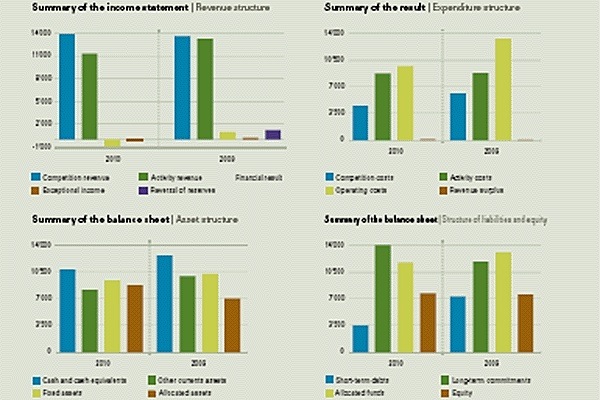In this instalment of our continuing series looking at some of the key issues in the revenue sharing debate, we continue to labour through the UCI’s recently-released financial statements for 2010. We also pause to consider the true nature of accountancy.
Question: How much sponsorship income did the UCI have in 2010? Hands up those of you who said none? Oh dear. So many.
Let’s clarify something for those who think that the UCI had no sponsorship income in 2010: according to the UCI’s recently-released accounts, there was zero income from UCI sponsors last year (compared with 5,482 Swiss francs in 2009 and 163,861 Swiss francs in 2008). That is not the same as saying that there was no sponsorship income.
How? Simple. It’s a language game. The UCI accounts refer to UCI sponsors. If you read the full accounts, you’ll find that the UCI have sponsorship agreements with Patrick/Safety Jogger, Santini, Shimano, Skoda, Swatch and Tissot. These cover the World Championships, World Cups and other UCI-organised events. So where’s the money from these sponsors buried, then? In the competitions to which it relates. The UCI itself has no sponsors. But UCI events continue to be sponsored. And, by associating sponsors with events rather than the UCI, the income from those sponsors can be buried far from prying eyes. Like a tree you need to hide, the UCI’s sponsorship income is buried in a forest. A forest of numbers.
* * * * *
Question: what was the UCI’s income in 2010? Was it: A) 25.6 million Swiss francs; B) 33.4 million Swiss francs; or C) 39.9 million Swiss francs?
Hands up those of you feeling smug with yourselves at having plumped for 25.6 million Swiss francs? Well wipe that smile off your face because it was a trick question. The correct answer is all three. Welcome to the surreal world of accountancy.
Accountancy, for those of you who don’t get it, is an art, not a science. Most people think it’s just bean counting: one bean plus two beans equals three beans and so on until you know exactly how many beans it takes to make an espresso. Most people are wrong. Accountancy is all about story-telling. Sometimes it’s about telling heroic tales of derring-do, inflated revenue lines, and massive profits. Other times it’s about crafting a misery memoir, hardly any revenue, and most of it wiped out by costs. In order to know which story you’re going to tell, you have to know your audience. Investors? They usually want tales of derring-do. The taxman? Better give him a misery memoir.
The audience for the UCI accounts is a bunch of greedy bastards who, if they see massively-inflated revenue lines, will want a bigger slice of the cake for themselves.
Let’s take a look at those UCI income numbers and the different stories that could be told. First, the top-line revenue as reported in the recently-released UCI accounts:
|
2010 |
2009 |
2008 |
|
| Competition income (World Championships, World Cups, other competions and sponsorships) |
14,010,941 |
13,574,924 |
17,050,142 |
| Other income (licences, federations, IOC etc) |
11,542,141 |
13,242,345 |
13,634,067 |
| Total Income Option A |
25,553,082 |
26,817,269 |
30,684,209 |
To this figure we could – had the UCI not hived them off to a special purpose vehicle (SPV) – add in the amounts levied upon riders, teams, and race organisers to cover the cost of anti-doping:
|
2010 |
2009 |
2008 |
|
| Total Income Option A |
25,553,082 |
26,817,269 |
30,684,209 |
| CADF income |
7,887,000 |
7,658,000 |
0 |
| Total Income Option B |
33,440,082 |
34,475,269 |
30,684,209 |
Having done that, we could also add in the income from the World Cycling Centre (CMC), had the UCI not also hived its activities off to another SPV:
|
2010 |
2009 |
2008 |
|
| Total Income Option B |
33,440,082 |
34,475,269 |
30,684,209 |
| CMC income |
6,418,000 |
2,862,000 |
1,958,000 |
| Total Income Option C |
39,858,082 |
37,337,269 |
32,642,209 |
Three different income numbers. Three very different income numbers. And all of them not incorrect.
* * * * *
Why is any of this important? Simple: because people see a headline figure and get all excited about it. Only they haven’t got a clue what they’re really getting excited about. Some of this is the fault of the accountants. They are, as we’ve established, telling a story. The art of misdirection is part of the storyteller’s armoury. Why shouldn’t accountants use it? The UCI’s storytellers are simply trying to play down the amount of money that flows through the UCI’s accounts each year. (There are other, much darker, forces which may be at play in the hiving off of some of the UCI’s activities to special-purpose vehicles, some of which you’re already aware of. For the moment, we’ll ignore them. Important as they are, they’re not part of this story.)
It should also be noted, however, that some of the people who pull a number out of an income statement and get all excited about it are also at fault here. Consider the response recently by some to the fact that the UCI had income of 12 million Swiss francs in 2010 from the World Championships. All they were short of doing was shouting “Cwoar! Look at the francs on that!”
Let’s throw a bucket of cold water over this figure:
|
2010 |
2009 |
2008 |
|
| World Championships income |
11,924,069 |
11,334,064 |
14,274,320 |
| Direct costs of World Championships |
(1,467,693) |
(2,258,151) |
(3,448,994) |
| Net World Championships income |
10,456,376 |
9,075,913 |
10,825,326 |
The World Championships come with costs attached. Considering the revenue figure without reference to those costs is plain dumb. Okay, you say, but in this case the expenses are not very large and we’ve only gone from 12 million Swiss francs to 10.5 million Swiss francs, what’s 1.5 million Swiss francs between friends? (About €1.2 million at the year-end exchange rate! – Ed)
But what is actually being referred to here? The World Championships, what are they? For a lot of cycling fans, they are just the road championships. But there’s a lot more to them than that.
|
2010 |
2009 |
|
| World Championships Income | ||
| Road |
8,565 |
7,525 |
| Track |
967 |
946 |
| Cross |
667 |
769 |
| MTB |
983 |
1,384 |
| BMX |
531 |
609 |
| Other |
191 |
101 |
| Total World Championships Income |
11,924 |
11,334 |
For those to whom the World Champions are only about the road events then, we’ve gone from 12 million Swiss francs income to 10.5 million Swiss francs net income and now down to just 8.6 million Swiss francs income coming from the road events, without knowing what the matching cost of those road events was. The cake slice gets smaller each time we try to measure it accurately.
But why single out the World Championships? Why did those who trumpeted loudly the 12 million Swiss francs figure not also consider the 2.1 million Swiss francs revenue from other events? Possibly for this reason: those events lose money.
|
2010 |
2009 |
2008 |
|
| World Cups income |
2,054,086 |
2188628 |
2,576,949 |
| Other competitions |
32,786 |
46,750 |
35,022 |
|
2,086,872 |
2,235,378 |
2,611,971 |
|
| World Cups direct costs |
(2,988,055) |
(3,843,685) |
(4,325,318) |
| Other competitions direct costs |
(43,297) |
(46,162) |
(41,995) |
|
(3,031,352) |
(3,889,847) |
(4,367,313) |
|
| Net World Cups defecit |
(933,969) |
(1,655,057) |
(1,748,369) |
| Net other competions defecit |
(10,511) |
588 |
(6,973) |
| Net defecit on other events |
(944,480) |
(1,654,469) |
(1,753,342) |
Here, for me, is the important point: people who single out an inappropriate revenue figure without both considering the direct costs associated with it and the other events it subsidises are making a very weak argument.
Which is a fair way of summing up the whole revenue-sharing debate that the AIGCP attempted to ignite over the summer at the Tour de France. It has been, so far, a very weak argument. A headline figure – $200 million – was waved about and a share of it was demanded. No consideration was given to the accurancy of this figure. No consideration was given to the costs associated with this figure. No consideration was given to other events, all that mattered was the Tour. And no real consideration was given to the fact that the teams are already in receipt of a negotiated share of the Tour’s revenue.
All of these points we will be returning to later in this series. But, before we do that, we’ll complete our look at the UCI’s most recent financial report.
Next: Measuring the UCI’s cholesterol levels.
Previously: The UCI’s role in the revenue-sharing debate















2 Comments
[…] Where do you hide a tree? Tags: GCP, Global Cycling Promotion, UCI, UCI Accounts 2010 function fbs_click() […]
[…] Conclusion A quick look upon publication shows slightly stronger results for the UCI in 2011, building in 2010 which was also mildly profitable but we probably need to go over the accounts with a finer comb to double-check some of the items because as fellow blogger FMK explained last year, things aren’t always as they seem with the UCI accounts. […]